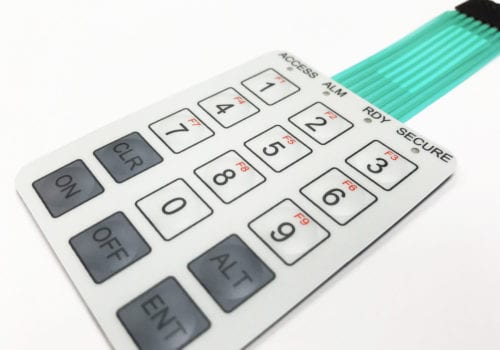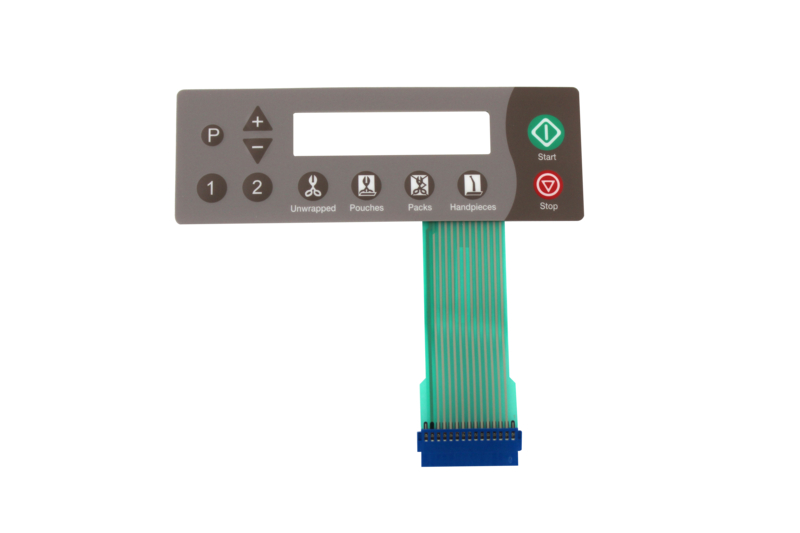An innovative membrane switch manufacturer can offer next-gen features and materials.
An innovative membrane switch manufacturer can offer next-gen features and materials.
Blog Article
All Regarding Membrane Layer Change: Comprehending Its Design and Performance
When you believe regarding the control interfaces in modern-day tools, membrane layer switches often come to mind. These parts are greater than simply buttons; they mix layout and capability seamlessly. Recognizing how they function and what makes them effective can transform your viewpoint on day-to-day electronics. However, there are nuances to their style and performance that you might not know. Let's discover what collections membrane switches over besides other control systems.
What Are Membrane Layer Switches?

Their smooth nature makes them easy to clean and immune to dirt and wetness, an important attribute in lots of settings. Membrane switches can likewise be personalized regarding shape, dimension, and graphics, permitting producers to develop unique user interfaces tailored to certain items. And also, they're light-weight and thin, which helps in minimizing the total mass of gadgets. Generally, membrane buttons play a considerable duty in enhancing user experience across a vast variety of applications.
Exactly How Membrane Layer Switches Over Work
When you push a trick on a membrane layer switch, it turns on a simple yet efficient mechanism. The top layer, often made of adaptable product, lowers onto a conductive layer below it. This activity bridges the gap between conductive traces, finishing an electrical circuit. As quickly as the circuit shuts, it sends a signal to the tool's controller, which translates your input.
You'll notice that the tactile feedback varies based on the button layout, using either a soft click or a more obvious response. When you release the secret, the membrane layer go back to its original setting, resuming the circuit and stopping the signal. This procedure occurs nearly instantaneously, making certain a receptive individual experience.
Membrane buttons are popular because of their durability and resistance to dust and moisture, making them ideal for various applications, from house devices to medical devices. Comprehending this operation assists you appreciate their extensive use.
Key Components of Membrane Layer Switches
Recognizing the essential components of membrane switches is fundamental for grasping their capability and style. At the core, you'll locate the visuals overlay, which supplies the aesthetic interface for customers. Below that, there's a spacer layer that divides the circuit layers, guaranteeing that they don't make call till pushed. The circuit layer is where the magic takes place; it contains conductive traces that complete the circuit when you press the button. Another crucial element is the glue support, enabling the button to stick to surface areas safely. The safety layer shields against ecological variables and use, extending the switch's life-span. Each part plays a significant role in making certain reputable performance and user interaction. By recognizing these parts, you'll gain insight right into just how membrane switches over run and their significance in numerous applications.
Materials Made Use Of in Membrane Layer Change Design
The efficiency and durability of membrane layer changes greatly depend upon the materials utilized in their design. You commonly come across polyester and polycarbonate as main substrates as a result of their excellent toughness and flexibility. These materials stand up to scrapes and chemicals, making them excellent for requiring environments.
The conductive layers commonly make use of silver or carbon, selected for their dependability and conductivity. membrane switch manufacturer. Silver provides premium efficiency, while carbon is an affordable choice. For the overlay, you may think about a matte or shiny coating, depending on your visual demands and individual experience
Make specific to pick adhesives that endure try this out environmental variables like temperature and moisture. Selecting the ideal materials will ensure your membrane layer switch stands the examination of time.
Style Factors To Consider for Membrane Switches
While making membrane buttons, it's vital to take right into account different elements that influence their performance and user experience. Begin by concentrating on the design and button dimension; make certain they're user-friendly and simple to browse.
Verify your design fits environmental factors, like wetness or temperature variants, which could impact efficiency. By carefully thinking about these aspects, you'll produce a membrane switch that boosts usability and contentment.
Applications of Membrane Layer Switches
Membrane switches are flexible elements discovered in various applications, from commercial tools to customer electronics. You'll see their influence in machines that require resilient interfaces and in tools that take advantage of smooth designs. Comprehending these applications assists you appreciate the performance and usefulness of membrane switches in day-to-day innovation.
Industrial Tools Use
When you're looking to boost the performance of industrial devices, membrane layer switches offer a dependable service that incorporates longevity with easy to use style. These buttons are best for rough environments, providing resistance to dust, moisture, and chemicals. You'll locate them in control panels for manufacturing devices, link cooling and heating systems, and medical tools, where accuracy and responsiveness are essential. Their reduced account implies they fit flawlessly into various devices, saving valuable room while keeping simplicity of usage. With customizable graphics and backlighting alternatives, you can create an intuitive interface for drivers, enhancing performance and safety and security. Plus, their lengthy life-span reduces maintenance prices, making them a wise financial investment for your industrial applications. Embrace membrane buttons to enhance your procedures and improve general performance.
Customer Electronic Devices Assimilation
In the domain of consumer electronic devices, membrane buttons play a crucial function in improving individual interaction and gadget this content performance. Membrane switches also assure sturdiness and resistance to dust and moisture, extending the life expectancy of your electronic devices. By choosing membrane layer switches, you enhance not just the performance yet also the design of your devices, making day-to-day interactions smooth and delightful.
Benefits and Negative Aspects of Membrane Layer Switches
While membrane layer switches offer a range of benefits, they likewise come with some drawbacks that you should consider. One substantial benefit is their small design, making them ideal for space-constrained applications.

Nonetheless, there are drawbacks. Membrane buttons can have a much shorter lifespan compared to mechanical switches, particularly under heavy usage. They can additionally be much less responsive, which may influence user comments throughout procedure. If harmed, repairing them can be tough and commonly requires complete substitute. Inevitably, their sensitivity to severe temperatures and environmental problems may limit their effectiveness in particular setups. Balancing these benefits and drawbacks will help you establish if membrane buttons are the right fit for your project.
Often Asked Inquiries
How Long Do Membrane Layer Changes Normally Last?
Membrane layer switches usually last between 5 to 10 years, depending on usage and environmental conditions. You'll want to evaluate aspects like wear, direct exposure to wetness, and temperature level fluctuations to gauge their longevity efficiently.
Can Membrane Switches Be Custom-made for Certain Designs?
Yes, you can customize membrane switches to fit details styles (membrane switch manufacturer). You'll have the liberty to choose shades, forms, and layouts that match your job's demands, ensuring they blend flawlessly with your overall aesthetic
What Is the Expense Range for Membrane Change Manufacturing?
The price range for membrane layer switch manufacturing typically falls between $1 and $10 per system, depending upon variables like design complexity, amount, and products. You can get quotes from makers to locate the most effective choice.

Are Membrane Layer Changes Water Resistant or Resistant?
Membrane layer buttons can be developed to be water resistant or resistant, depending upon materials utilized and building and construction techniques. If you need them for damp environments, guarantee you specify those requirements throughout the layout procedure.
Just How Do Membrane Switches Contrast to Typical Switches?
Membrane layer switches are generally thinner and a lot more adaptable than typical buttons, supplying a smooth design. They're frequently simpler to clean up and incorporate, yet could not give the responsive comments you're made use of to with mechanical alternatives.
Final thought

Report this page